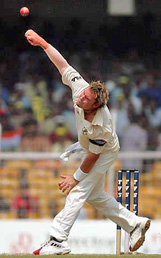COACHING
Leg-Spin - An Introduction
- By SP. Bhatia Right-arm off-spin and left-arm orthodox spin involve the use of the fingers. On the other hand, the wrist of the bowling hand plays a dominant part in right-arm leg-spin and left-arm unorthodox (chinaman) spin. Leg-spin bowling is one of cricket's most attractive, and difficult aspects. It is an art in itself, which needs to be looked at closely, and studied minutely.The stock ball of a leg-spinner is the leg-break, wherein the ball changes direction from the leg-stump to the off-stump after pitching. As the ball is released, the bowler's wrist flips over towards the batsman while the third finger spins the ball along the seam.

Shane Keith Warne, Leg-spinner Extraordinaire.
Leg-spin bowlers tend to have a shorter run-up.
They run at a slight angle towards the popping
grease, to help them retain their side-on position.
A leg-spinner can take lot of wickets if he
continues to bowl accurately. If he is not accurate
enough, he runs the risk of getting a pasting.
1. Place the first and second fingers across the seam at the top. The third finger should be bent and lie along the seam. The ball should not be rested on the thumb. You have to flick your wrist forwards as you release the ball, so that your palm faces the ground. Keep looking forward as you lean away from the batsman, stand tall and keep your back straight. To help you stand side-on, keep the back foot as parallel to the crease.
2. Rotate the wrist to achieve maximum spin, swing the bowling arm backwards and upwards, keeping it close to your right ear. The arm should move over your head. Transfer your weight onto your front foot.
The grip for the leg-break:
1. Place the first and second fingers across the seam at the top. The third finger should be bent and lie along the seam. The ball should not be rested on the thumb. You have to flick your wrist forwards as you release the ball, so that your palm faces the ground. Keep looking forward as you lean away from the batsman, stand tall and keep your back straight. To help you stand side-on, keep the back foot as parallel to the crease.
2. Rotate the wrist to achieve maximum spin, swing the bowling arm backwards and upwards, keeping it close to your right ear. The arm should move over your head. Transfer your weight onto your front foot.
3. Release the ball from as high as possible, keeping your head upright and steady, and keep your front knee steady. As you swing the right arm forward, pivot your body around on your left foot and flick the ball as it leaves your hand, so that your palm ends up facing the ground. Spin the ball using your third finger and make sure that the left arm does not drop to the side after you release the ball.
4. Use the left arm to balance the body as your weight moves forward after delivering the ball. Make sure that your follow-through is energetic and powerful. Bring the right arm down and past your left thigh as you complete the action.
5. Watch the ball as it pitches and be prepared for a return catch.
There are different types of leg-spinners. There may be some like Bill O'Reilly (Australia), Bhagwat Chandrashekhar (India) and Anil Kumble (India), who belong to the 'fast off the wicket' club. These bowlers relied, and in Kumble's case, rely, on speed and bounce along with accuracy. Then there are others like Clarrie Grimmett (Australia) and Subhash Gupte (India), who were huge turners of the ball. It used to be said of them that they could turn the ball even on a glass surface! Shane Warne, the highest wicket-taker in Test cricket, is a member of this fraternity of 'turners'. The quality leg-spinner has a lot of tricks and variations up his sleeve. Each of them will be examined and explained in the subsequent articles